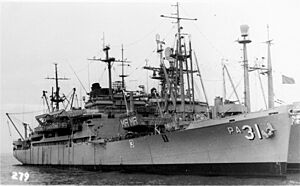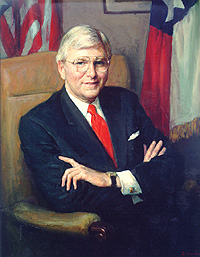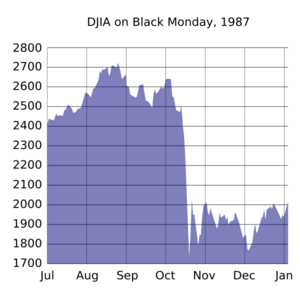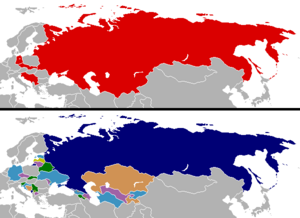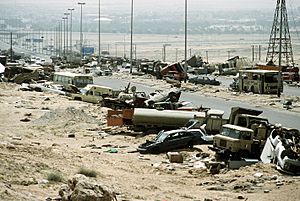James Baker facts for kids
Quick facts for kids
James Baker
|
|
|---|---|

Official portrait, 1989
|
|
| 10th & 16th White House Chief of Staff | |
| In office August 24, 1992 – January 20, 1993 |
|
| President | George H. W. Bush |
| Deputy | Robert Zoellick |
| Preceded by | Samuel K. Skinner |
| Succeeded by | Mack McLarty |
| In office January 20, 1981 – February 3, 1985 |
|
| President | Ronald Reagan |
| Deputy | Michael Deaver |
| Preceded by | Jack Watson |
| Succeeded by | Donald Regan |
| 61st United States Secretary of State | |
| In office January 25, 1989 – August 23, 1992 |
|
| President | George H. W. Bush |
| Deputy | Lawrence Eagleburger |
| Preceded by | George Shultz |
| Succeeded by | Lawrence Eagleburger |
| 67th United States Secretary of the Treasury | |
| In office February 4, 1985 – August 17, 1988 |
|
| President | Ronald Reagan |
| Deputy | Richard G. Darman M. Peter McPherson |
| Preceded by | Donald Regan |
| Succeeded by | Nicholas F. Brady |
| United States Under Secretary of Commerce | |
| In office August 2, 1975 – May 7, 1976 |
|
| President | Gerald Ford |
| Preceded by | John Tabor |
| Succeeded by | Edward Vetter |
| Personal details | |
| Born |
James Addison Baker III
April 28, 1930 Houston, Texas, U.S. |
| Political party | Republican (since 1970) |
| Other political affiliations |
Democratic (before 1970) |
| Spouses |
Mary Stuart McHenry
(m. 1953; died 1970)Susan Garrett
(m. 1973) |
| Children | 5 |
| Relatives | Rosebud Baker (granddaughter) |
| Education | Princeton University (BA) University of Texas at Austin (LLB) |
| Signature | |
| Military service | |
| Allegiance | United States |
| Branch/service |
|
| Years of service | 1952–1954 (active) 1954–1958 ([reserve) |
| Rank | Captain |
James Addison Baker III (born April 28, 1930) is an American lawyer, diplomat, and statesman. He was a key figure in the Republican Party. He served as the 10th and 16th White House Chief of Staff and the 67th United States Secretary of the Treasury under President Ronald Reagan. Later, he became the 61st U.S. Secretary of State under President George H. W. Bush.
Born in Houston, Texas, Baker went to Princeton University and served in the United States Marine Corps. After law school, he became a lawyer. He became good friends with George H. W. Bush and helped with Bush's political campaigns. Baker held several important government jobs throughout his career.
Baker played a big role in many major events. He helped manage presidential campaigns and served in top government positions. As Secretary of State, he helped guide U.S. foreign policy during the end of the Cold War and the dissolution of the Soviet Union. He also played a part during the Gulf War. After leaving government, he continued to be active in public affairs. He is known for his work on the Iraq Study Group and for the James A. Baker III Institute for Public Policy at Rice University.
Contents
Early Life and Education
James Addison Baker III was born in Houston, Texas. His mother was Bonner Means Baker. His father, James A. Baker Jr., was a partner at a Houston law firm called Baker Botts. This firm was started by Baker's great-grandfather in 1871.
Baker's father was a very strict person. He taught Baker the "Five Ps": "prior preparation prevents poor performance." Baker said this advice helped him almost every day of his adult life. His father also did not want him to get involved in politics.
Baker went to the Kinkaid School in Houston. For his last two years of high school, he attended the Hill School in Pennsylvania.
After high school, Baker went to Princeton University. He studied history and graduated in 1952. While at Princeton, he joined a U.S. Marine officer training program. This helped him avoid being drafted during the Korean War.
Military Service
Baker served on active duty with the Marines from 1952 to 1954. He was a naval gunfire spotter in the Mediterranean Sea aboard the USS Monrovia. He stayed in the Marine Corps Reserve until 1958, reaching the rank of captain.
Law Career
After his military service, Baker attended the University of Texas School of Law. He graduated and planned to join his family's law firm, Baker Botts. However, the firm had a rule against family members working there if their fathers were still partners. So, Baker could not join at that time.
From 1957 to 1980, Baker worked at another law firm, Andrews, Kurth, Campbell, & Bradley. He helped clients with things like drafting rules for their businesses and advising on company mergers. Most of the firm's work was in the oil and gas industry in Texas. Baker worked long hours and was very dedicated to his job.
Early Political Career
Before his active political career, Baker considered himself not very interested in politics. He was a registered Democrat in Texas, but he often voted for Republican presidential candidates.
Baker's first wife, Mary Stuart McHenry, was active in the Republican Party. She supported the campaigns of George H. W. Bush. Baker also became close friends with Bush through playing tennis. These connections influenced Baker's political views.
In 1970, Baker helped his friend George H.W. Bush run for the Senate in Texas. Baker led Bush's campaign efforts in Harris County, helping with fundraising and support. Bush lost that election.
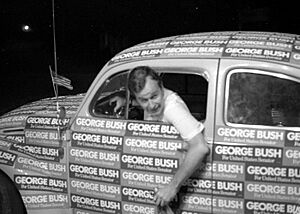
After the 1970 campaign, Baker returned to his law practice. He later became the Finance Chair for Richard Nixon's re-election campaign in Texas in 1972.
Ford Administration Role
In 1975, Baker was appointed Under Secretary of Commerce under Rogers Morton. Morton chose Baker after speaking with George H. W. Bush, who was then the U.S. Ambassador to China.
As Under Secretary, Baker helped with economic discussions in the White House. He also played a role in President Gerald Ford's 1976 re-election campaign. Baker became Ford's "delegate wrangler" at the 1976 Republican National Convention, helping to secure Ford's nomination.
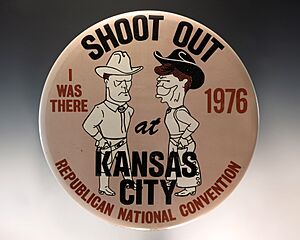
After the convention, Baker became the chairman of Ford's campaign. He helped arrange the first televised presidential debates since 1960. Ford lost the election to Jimmy Carter, but Baker received credit for improving Ford's chances and closing the gap in the polls.

Texas Attorney General Campaign
After the 1976 election, Baker decided to run for Texas Attorney General in 1978. He ran as a moderate Republican. He supported civil rights protections and conservative views on other issues. National Republican figures like Ronald Reagan and Gerald Ford campaigned for him.
Baker lost the race to Democratic nominee Mark White by a significant margin. Despite this loss, he remained interested in national politics.
1980 Presidential Election
In 1980, Baker helped his friend George H.W. Bush run for the Republican presidential nomination. Baker believed that strong organization was key to winning primary elections.
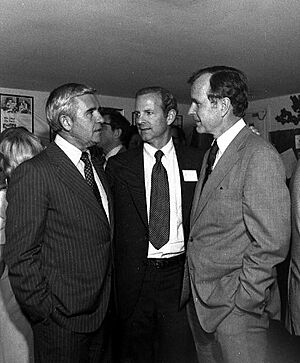
Bush won the Iowa caucus, but then lost the New Hampshire primary to Ronald Reagan. Baker eventually advised Bush to end his campaign, suggesting it would help Bush become Reagan's Vice President. Bush agreed, and Reagan later chose Bush as his running mate.
Baker then worked on the Reagan campaign, focusing on managing the presidential debates. He negotiated with the Democratic team to set up the debates.
White House Chief of Staff (1981–1985)
After Reagan won the 1980 election, he appointed James Baker as his White House Chief of Staff. This was a very powerful position, overseeing the daily operations of the White House.

Baker, along with Edwin Meese and Michael Deaver, formed an informal group called "The Troika." Baker managed daily issues and negotiations. This group controlled access to President Reagan and had a big say in hiring and firing decisions. Many people believed Baker had a lot of influence during Reagan's first term.
Reagan Assassination Attempt
In March 1981, John Hinckley Jr. tried to shoot President Reagan. Baker was not with Reagan at the time but went to the hospital where Reagan was in critical condition. Baker and other advisors decided not to use the Twenty-Fifth Amendment to make Vice President Bush acting president. Baker wanted to avoid any actions that might cause distrust among conservatives.
Baker also limited access to Reagan during his recovery. He worried that if the public knew how ill Reagan was, it might cause doubts about his leadership.
1984 Re-election Campaign
Baker began planning Reagan's re-election campaign in 1982. Although he was not the official campaign chairman, he had a lot of power over the campaign's operations.
Baker helped shape the Republican party platform for 1984. He ensured that Reagan's actions as president were the main focus. Reagan won the election by a landslide, receiving 525 electoral votes and 58.8% of the popular vote. Baker was praised for helping to run a smooth and successful campaign.
Secretary of the Treasury (1985–1988)
In 1985, President Reagan appointed Baker as United States Secretary of the Treasury. This was part of a job swap with Donald Regan, who became White House Chief of Staff. Baker was excited about the prestige of the Treasury Department.
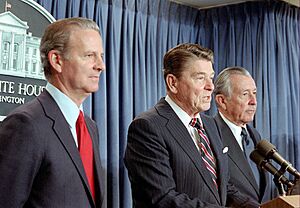
Baker brought his long-time aide, Richard Darman, to the Treasury Department as Deputy Secretary. Darman was known for his attention to detail, which complemented Baker's political style.

Tax Reform Act of 1986
One of Baker's main goals at the Treasury was to change the tax code. He worked with members of Congress to create a new plan. The goal was to make the tax system simpler and fairer.
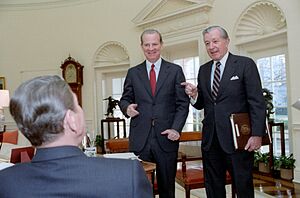
Baker's plan aimed to:
- Keep government revenue the same.
- Lower the top income tax rate for individuals.
- Remove millions of lower-income families from paying taxes.
- Keep the popular mortgage interest deduction.
The bill passed both the House and Senate and was signed into law by President Reagan in October 1986. Baker received credit for helping to create this major tax reform.
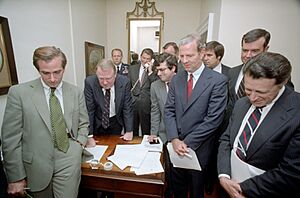
Plaza Accord
Baker also focused on the value of the U.S. dollar. He believed a strong dollar was hurting American industries and increasing trade deficits.

In September 1985, Baker met with finance ministers from Japan, France, West Germany, and the United Kingdom at the Plaza Hotel in New York City. They agreed to sell their American currency to lower the dollar's value. This agreement was called the Plaza Accord. It aimed to help American businesses by making their products cheaper for other countries to buy.
1987 Stock Market Crash
In October 1987, the Dow Jones Industrial Average experienced its largest single-day drop in value. This event became known as "Black Monday." Baker's comments about the dollar's value were seen by some as a contributing factor to the crash. However, investigations later showed that many factors, including computer trading and market psychology, played a role.
Secretary of State (1989–1992)
President George H. W. Bush chose James Baker as his Secretary of State the day after he won the election. The Senate quickly confirmed Baker in January 1989.

Baker's close relationship with President Bush made him a very powerful figure in foreign policy. He was seen as a strong voice for America on the world stage.
Nicaragua and Iran-Contra
One of Baker's first goals was to reduce American involvement in Latin America. He worked with Congress to stop military funding for the Contra rebels in Nicaragua. Instead, the U.S. focused on providing humanitarian aid. Baker also worked with the Carter Center to ensure the 1990 election in Nicaragua was fair. The anti-Sandinista candidate, Violeta Chamorro, won the election.
The Soviet Union's Changes
Baker played a big part in how the U.S. dealt with the dissolution of the Soviet Union. As Soviet member states started to declare independence, Baker visited many of these countries.
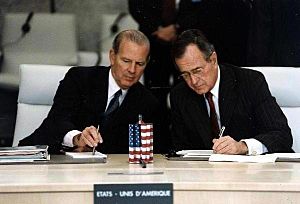
German Reunification
Baker was heavily involved in talks to reunify Germany after the Berlin Wall fell in 1989. He was the first American official to visit East Berlin after the wall came down. Baker negotiated with the Soviets and West German officials on the "Two Plus Four" plan. This plan allowed the two parts of Germany to reunite, with the agreement of the four major powers (U.S., Soviet Union, UK, France). The Treaty on the Final Settlement with Respect to Germany was signed in September 1990, leading to a unified Germany by March 1991.
Soviet Dissolution
During Baker's time as Secretary of State, the Soviet Union transformed from one large communist state into 15 different democratic republics. Baker visited many of these new countries, including Ukraine, Poland, and the Baltic states.
The U.S. supported some Soviet actions to maintain order but also warned against using force, especially in places like Lithuania. Baker tried to mediate conflicts and focused on arms reduction and economic help.
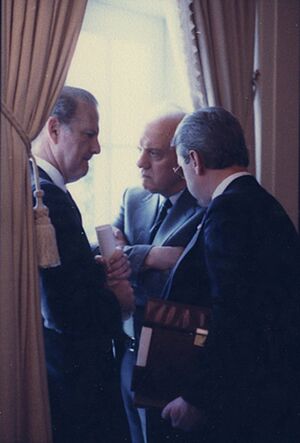
In June 1991, Baker was the first U.S. representative to officially visit Albania. He spoke about Albania rejoining the world system after the end of Soviet influence.
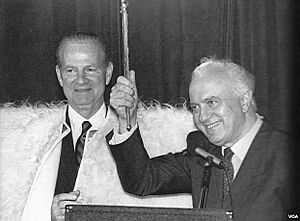
As the Soviet Union broke apart, Baker urged caution. He worried that too much rapid change could lead to chaos and civil war in the new independent states.
Iraq and the 1991 Gulf War
In 1990, Iraqi President Saddam Hussein began to threaten Kuwait. On August 2, 1990, Hussein's forces invaded Kuwait. Baker was with Soviet foreign minister Eduard Shevardnadze when the news broke. They quickly issued a joint statement condemning the invasion and calling for the UN Security Council to get involved.
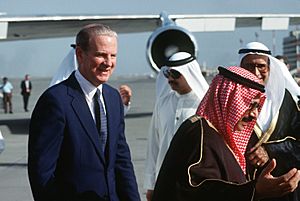
Baker traveled extensively to gather political and financial support for military action against Iraq. He visited many countries, including the Soviet Union, the United Kingdom, and Saudi Arabia. He also secretly met with the Chinese foreign minister to ensure China would not block UN action.
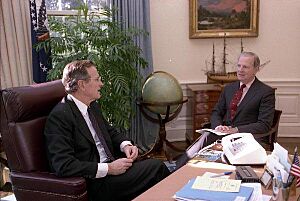
In November 1990, the UN Security Council passed a resolution. It stated that if Iraq did not leave Kuwait by January 15, 1991, other countries could use "all necessary means" to make them comply. Baker personally attended the UN meeting to show America's commitment.
The coalition began bombing Iraq on January 17. The ground offensive started on February 24 and ended on February 28, when Iraqi troops fled Kuwait. Baker and other advisors decided not to continue the offensive further into Iraq.
Baker was praised for his role in coordinating international support for the war. Many countries contributed funds to offset the costs for the U.S.
Arab-Israeli Conflict
Baker approached the Arab-Israeli conflict with caution. In May 1989, he gave a speech where he urged Israel to give up the idea of a "greater Israel" and stop building settlements in the West Bank and Gaza. He also said that Palestinians deserved political rights.
In 1990, Baker publicly criticized Israeli leadership for not being serious about peace. He even gave out the State Department's phone number, saying Israel should call "when [they] are serious about peace."
Madrid Conference
After the Gulf War, Baker helped organize the Madrid Conference of 1991. This was a major peace conference that brought together all parties involved in the Arab-Israeli conflict. It was the first time the U.S. officially negotiated directly with Palestinians.
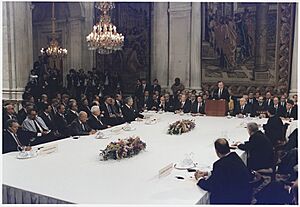
Baker worked to create a multi-party negotiation between Israel, Palestine, and its neighbors. He set conditions for participation, ensuring that the conference could move forward.
White House Chief of Staff (1992–1993)
In August 1992, with President Bush trailing in the polls for the 1992 election, Baker returned to the White House as Chief of Staff. He also led Bush's re-election campaign.

Despite Baker's past success in Republican campaigns, Bush lost the 1992 election to Bill Clinton.
Post-Government Career
After leaving government in 1993, James Baker remained active in public life.
- In 1993, he became the honorary chair of the James A. Baker III Institute of Public Policy at Rice University.
- He also joined the law firm Baker Botts as a senior partner.
- From 1997 to 2004, Baker served as the Personal Envoy for the UN Secretary-General for Western Sahara. He worked to find a peaceful solution to the conflict there.
2000 Presidential Election Recount
In 2000, Baker was the chief legal adviser for George W. Bush during the 2000 presidential election. He oversaw the Florida recount, a very close and controversial election. The 2008 film Recount tells the story of those days.
Roles During the Bush Administration
Baker also advised President George W. Bush on Iraq. In 2003, he was appointed as a special envoy to ask other countries to forgive or restructure Iraq's international debts.
In 2006, Congress formed the Iraq Study Group, a panel of former officials to study America's policy in Iraq. Baker was the Republican co-chairman of this group. The group explored different ideas for the future of Iraq.
Recent Activities
Baker voted for Donald Trump in both the 2016 and 2020 presidential elections. He also gave informal advice to Trump's 2016 campaign.
He serves on the Honorary Council of Advisers for the U.S.-Azerbaijan Chamber of Commerce. He is also an Honorary Co-Chair for the World Justice Project, which works to strengthen the Rule of Law globally.
Baker is a leader of the Climate Leadership Council. In 2017, this group of Republican leaders proposed a carbon tax plan to address climate change.
Personal Life
James Baker met his first wife, Mary Stuart McHenry, in Bermuda. They married in 1953 and had four sons. Mary Stuart Baker passed away in 1970.
In 1973, Baker married Susan Garrett Winston, a friend of his first wife. She had two sons and a daughter from a previous marriage. Together, James and Susan had a daughter, Mary Bonner Baker.
Baker is an avid hunter. He has gone on hunting trips around the world, including to Rhodesia (now Zimbabwe) and Mongolia. He even postponed a hunting trip in 2000 to help with the Florida recount.
In 2002, Baker's seven-year-old granddaughter, Virginia Graeme Baker, drowned in a spa due to suction entrapment. To promote pool and spa safety, Baker and his family helped form an advocacy group. This led to the Virginia Graeme Baker Pool And Spa Safety Act, a law designed to prevent similar accidents. Another granddaughter, Rosebud Baker, is a stand-up comedian.
Awards and Honors
- Jefferson Awards for Public Service (1985)
- Presidential Medal of Freedom (1991)
- Golden Plate Award of the American Academy of Achievement (1998)
 Grand Cordon of the Order of the Rising Sun (2015)
Grand Cordon of the Order of the Rising Sun (2015)
See also
 In Spanish: James Baker para niños
In Spanish: James Baker para niños


